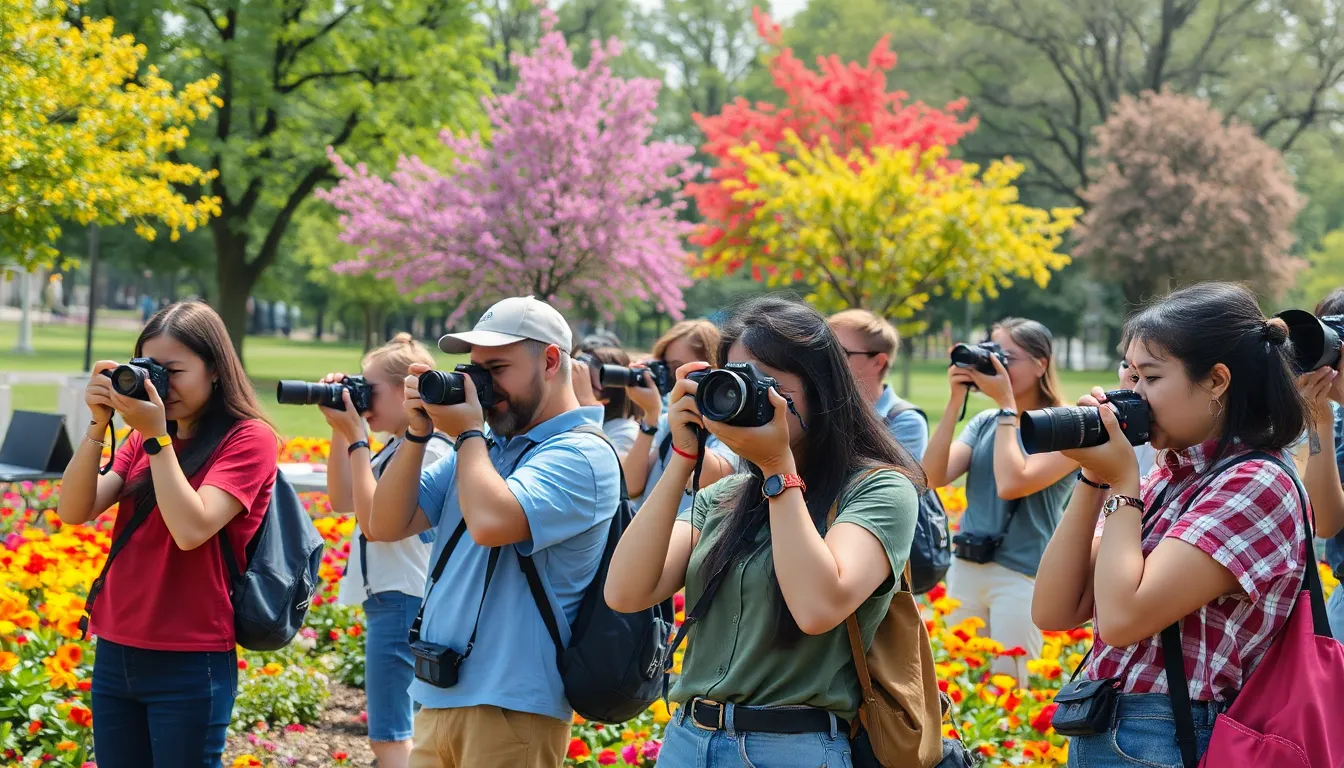In a world where everyone’s a photographer thanks to smartphones, standing out can feel like trying to find a needle in a haystack. Enter photography competitions, the ultimate playground for shutterbugs looking to showcase their talent and snag some serious bragging rights. Whether you’re a seasoned pro or a weekend warrior with a keen eye, these contests offer a chance to elevate your skills and gain recognition.
Table of Contents
ToggleOverview of Photography Competitions
Photography competitions serve as platforms that foster creativity. Participants include amateurs exploring their passion and professionals looking to elevate their careers. These contests often come with specific themes or categories, encouraging photographers to push their artistic boundaries.
Entry requirements can vary significantly. Some competitions ask for a single image submission, while others may require a series of works. Additionally, many competitions offer different divisions based on experience levels, ensuring a fair playing ground for everyone.
Judging criteria typically include aspects such as composition, creativity, and technical skill. Many renowned judges, often accomplished photographers or industry experts, lend their expertise to evaluate submissions. Top entries often receive prizes, ranging from cash awards to photography gear or exhibit opportunities, enhancing participants’ visibility.
Participating in photography competitions can boost visibility. Winning or even placing can provide significant recognition in the photography community. Furthermore, showcasing work in these competitions allows for networking opportunities with other artists and industry professionals.
Numerous photography competitions occur annually. Major contests, such as the Sony World Photography Awards or the National Geographic Photo Contest, attract thousands of entries globally. Localization often contributes to the prize distribution, with various regions hosting competitions that celebrate local talent.
Engaging in these competitions nurtures essential skills. Participants develop their abilities by adhering to the submission guidelines and responding to constructive feedback. Competitions also inspire creativity, as they challenge photographers to present unique perspectives on familiar subjects.
Types of Photography Competitions

Photography competitions come in various formats, catering to different levels of expertise and areas of interest. Each type offers distinct opportunities for photographers to exhibit their work.
Local Competitions
Local competitions generally focus on community engagement. These contests often encourage photographers to capture the essence of their surroundings. Entry requirements can vary, with some local competitions allowing free submissions to promote participation. Prizes usually consist of local recognition or small awards, helping participants connect with nearby artists and audiences. Local competitions serve as a nurturing ground for skill development, fostering creativity in a supportive environment.
National Competitions
National competitions raise the stakes, inviting submissions from across an entire country. Participants often face tougher competition due to the larger pool of entrants. Categories in national contests may range from landscape to portrait photography, allowing photographers to specialize. These competitions typically showcase high-caliber judges from the industry, who provide valuable feedback. Winners frequently earn significant prizes, such as cash awards or equipment, boosting their visibility in the national photography scene.
International Competitions
International competitions attract worldwide participation, offering a platform for global exposure. Photographers submit their work alongside thousands of international entries, fostering a diverse creative dialogue. Categories often include specific themes like wildlife or street photography, enhancing artistic expression. Entry fees vary, with many competitions providing prestigious awards to top contenders. Recognition in such a prestigious context can open doors to new opportunities and collaborations, significantly impacting a photographer’s career trajectory.
Benefits of Entering Photography Competitions
Photography competitions offer valuable advantages for participants, facilitating growth and recognition within the industry.
Exposure and Recognition
Winning or placing in a competition enhances a photographer’s visibility. Recognition from reputable contests can lead to increased opportunities, showcasing talent to potential clients and galleries. Competitions often publicize top entries through various channels, granting exposure to a broader audience. Additionally, accolades can strengthen a photographer’s portfolio, making it more appealing to prospective employers. Participation in well-known contests, such as the Sony World Photography Awards, significantly boosts credibility, attracting attention from industry professionals. Photographers frequently find that even entering competitions garners respect and acknowledgment among peers.
Networking Opportunities
Engaging in photography competitions opens doors to connect with fellow photographers and industry leaders. Building relationships within the photography community often occurs through these events. Participants interact with judges, who share insights and feedback, fostering professional growth. Networking at local and international competitions facilitates collaboration with other artists, expanding their creative horizons. Many competitions feature workshops or events aimed at skill development and interaction, allowing photographers to learn from each other. These connections can lead to future projects, resource sharing, and mentorship, creating a robust support network that elevates their work.
Tips for Success in Photography Competitions
Success in photography competitions requires attention to detail and an understanding of the specific requirements. Furthermore, adhering to guidelines often sets apart winning submissions from the rest.
Understanding the Rules
Comprehending the rules is crucial before entering any competition. Each contest varies in terms of submission formats, themes, and eligibility requirements. Photographers should carefully read all documentation provided by the organizers to avoid disqualification. Some competitions might limit entries to a specific number of images or dictate submission formats, such as file size or resolution. Additionally, Thumbnails or watermarks might be prohibited in certain contests. Knowledge of entry deadlines ensures timely submissions. Familiarity with the judging criteria can also enhance a photographer’s chances of success, allowing them to tailor their work to meet the expectations of judges.
Crafting Your Submission
Crafting a strong submission enhances competitiveness. Select images that not only align with the theme but also highlight technical skills and creative vision. Quality often trumps quantity; focusing on one or two strong photographs can be more effective than submitting many mediocre works. Resizing and editing images meticulously helps to meet the specifications of the competition while maintaining visual integrity. Photographers should consider accompanying captions or descriptions that provide context and insight into their artistic choices. Constructive feedback from peers often aids in refining submissions, leading to powerful final entries that stand out in judging rounds.
Popular Photography Competitions to Consider
Numerous photography competitions provide exciting opportunities for photographers to showcase their skills. The Sony World Photography Awards stands out as an annual global event that attracts entries from various artists. Competitors range from amateurs to professionals, highlighting diverse styles and themes.
Another notable contest is the National Geographic Photo Contest, renowned for its celebration of storytelling through photography. Participants can submit images that capture the essence of nature, culture, and exploration. This competition garners significant attention and can elevate a photographer’s profile.
Local photography competitions also present unique advantages. These contests encourage community involvement, allowing participants to connect with local artists. Many offer free submissions, enabling wider participation while still recognizing standout photographers in the area.
National competitions, such as the International Photography Awards, typically raise the stakes with their competitive nature. Categories focus on specialized techniques and provide judges with extensive expertise. This feedback often proves invaluable for photographers seeking to refine their craft.
International competitions, including the World Press Photo Contest, bring photographers from around the globe together. They promote cross-cultural dialogue and highlight pressing social issues through powerful imagery. Such contests often yield prestigious awards, which can significantly enhance a photographer’s career trajectory.
Emerging contests also gain popularity, providing fresh platforms for creative expression. Specific themes and innovative approaches distinguish these competitions, encouraging new perspectives. Opting for various types of contests allows photographers to tailor their strategies and explore different audiences.
Photography competitions offer invaluable opportunities for photographers to showcase their talent and gain recognition. By participating in these contests, they can enhance their skills while connecting with a vibrant community of fellow artists. Whether it’s a local event or an international showcase, each competition presents unique challenges and rewards that can significantly impact a photographer’s career.
Engaging with these contests not only boosts visibility but also fosters creativity and personal growth. As photographers navigate various themes and judging criteria, they learn to refine their artistic vision and technical prowess. Ultimately, photography competitions serve as a powerful catalyst for artistic development and professional advancement in an ever-evolving field.



